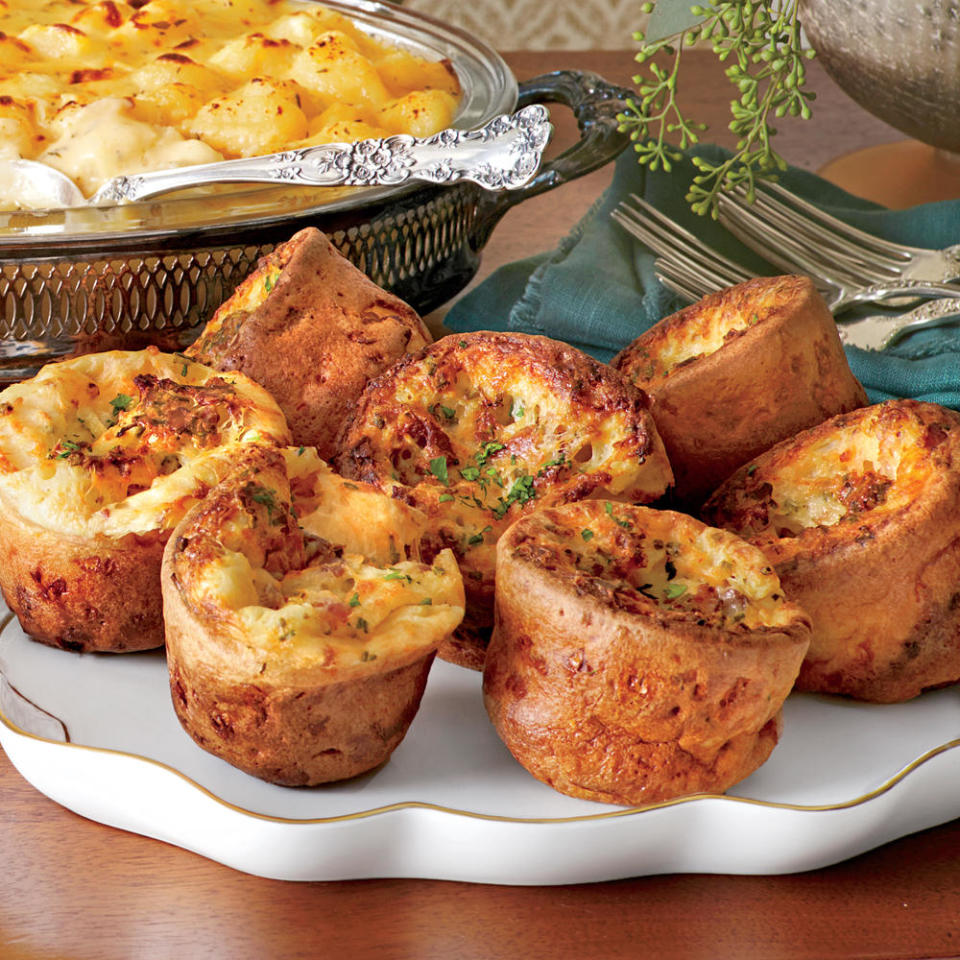What Is Yorkshire Pudding, Anyway?

Fans of the Great British Baking Show, Downton Abbey, or virtually any U.K.-based movie, book, or TV show have likely heard of Yorkshire pudding. But what is this mysterious British dish? Is it savory or sweet? And how the heck is it different from a popover?
What Is Yorkshire Pudding?

Yorkshire pudding is a British (usually) savory baked pudding.
To be clear, the British and American definitions of “pudding” are quite different.
If you’re from the U.S., the word likely evokes nostalgic memories of plastic cups filled with a thick, creamy chocolate dessert.
People in the U.K., however, will think of a sweet or savory dish—often including meat or animal fat—that is steamed or boiled.
British pudding is not one consistency. What Americans typically think of as “pudding,” many Europeans would call “custard.”
Yorkshire pudding batter is traditionally made from eggs, flour, and milk or water.
The iconic British dish can be served in a variety of ways. Commonly, it’s topped with gravy or served with meats.
It’s often served as a side dish for Britain’s traditional Sunday meal, known as “Sunday roast” or “Sunday lunch.”
Sometimes, it’s filled with other foods to make a complete meal. When sausage gets involved, Yorkshire pudding is called Toad in the Hole.
Related: What Is Figgy Pudding, Anyway?
Yorkshire Pudding vs. Popover
So is “popover” just another word for “Yorkshire pudding?” Yes—and no.
Though the dishes are made from the exact same batter, the difference lies in the way they are prepared and the way meat drippings come into play.
The American popover is cooked in a muffin tin that has been greased with the drippings from roasted beef or pork. The name comes from the way the edges “pop” over the sides as the batter cooks.
The British Yorkshire pudding can be prepared using a muffin tin, but it can also be baked in a pie pan, baking dish, or skillet. Some recipes for Yorkshire pudding call for the batter to be placed under roasting meat (instead of a drip pan) so that it can soak up the dripping fat.
Yorkshire Pudding History
WATCH: What is Figgy Pudding?
Yorkshire pudding actually originated as a way to use those leftover fat drippings.
The first recipe for “dripping pudding” was published in The Whole Duty of a Woman in 1737:
“Make a good batter as for pancakes; put in a hot toss-pan over the fire with a bit of butter to fry the bottom a little then put the pan and butter under a shoulder of mutton, instead of a dripping pan, keeping frequently shaking it by the handle and it will be light and savoury, and fit to take up when your mutton is enough; then turn it in a dish and serve it hot.”
The dish got its name after Hannah Glasse published a recipe for Yorkshire pudding in her 1747 cookbook The Art of Cookery.
So why did she choose to name it after the county of Yorkshire? Nobody knows for sure. But some people speculate that it has something to do with the area’s association with coal, as high heat is essential to the pudding’s crispy texture.
What Does Yorkshire Pudding Taste Like?
Traditional Yorkshire pudding is mild-tasting, but has distinct meaty flavors. If you’ve ever had a popover, you likely have some idea of what Yorkshire pudding tastes like.
How to Make Yorkshire Pudding

These days, you don’t have to place your Yorkshire pudding batter under a spit to enjoy its signature meatiness. Just save the fat from your next beef or pork roast and go from there.
Feeling inspired? Try your hand at one of our favorite Yorkshire pudding recipes:

